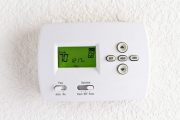(BPT) – Each winter, the inevitable happens as snow falls and the temperature inside and outside the home fluctuates — icicles form. While icicles are considered a common sight throughout the colder months, they can cause thousands of dollars in damage to your home.
While homeowners may not realize it, icicles are the result of ice dams that form on the roof. Ice dams can silently wreak havoc on roofs, leaving a trail of damage unseen until the snow and ice has all melted away. Wet insulation, damaged shingles, broken eaves and downpipes, and potential mold and mildew can be the result of ice dam formation.
Ice dams occur when key areas of your home’s roof space are under insulated. Warm, conditioned air penetrates through the roof to melt snow high on the roof. As the melted snow travels down the roof to the colder areas around the eaves, it refreezes, creating both an ice dam and icicles that trap any melted water underneath. This melted water eventually penetrates back through the roof into the attic space to dampen the existing insulation, which can lead to mold and mildew problems.
While it’s tempting to climb onto the roof and attempt to fix the problem yourself, it is dangerous to do so, as is trying to chip away the icicles from the ground. Energy Star recommends taking several steps to address the chance of ice dam formation before winter hits.
Prevent ice dams with spray foam insulation
Start defending against ice dams early by clearing away leaves and other debris from the eaves before the first snowfall. Energy Star suggests sealing your ducts as well as any air leaks before investing in additional insulation. Once you’ve taken these initial steps, you can help prevent ice dam formation by installing a high performance insulation material such as spray foam insulation. The airtight seal and high R-value delivered by spray foam insulation, such as Icynene, helps prevent any warm air from escaping through the roof, which leads to icicles and ice dams.
Installed by professionals, spray foam insulation works well in all climates to completely seal the building and stop air leakage. Not only does this help reduce the risk of ice dams forming, but also help reduces the strain on HVAC equipment that has to work overtime to compensate for the lost air. Spray foam insulation both insulates and air seals the home to help homeowners reduce their monthly heating and cooling bills.
As a long-term solution, spray foam insulation helps maintain a comfortable temperature year round while helping to control monthly heating and cooling expenses. While air leakage can cause bills to sky-rocket as well as lead to ice dams occurring, a well-insulated attic can help you get through the cold winter months comfortably. More information on how spray foam insulation can help curb icicles and ice dams can be found online at Icynene.com.

